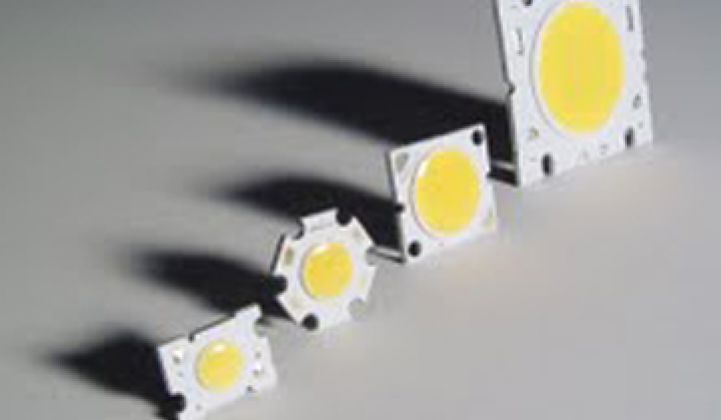Bridgelux, which makes light emitting diodes (LEDs) and other technology for solid state lights and bulbs, has raised $60 million in a fifth round of funding, according to an SEC filing.
The company to date has raised $180 million and it might add $20 million more to the current round. That's not the most ever raised by a green technology company. Solyndra raised over $1 billion from its investors. BrightSource Energy has raised $530 million. Fisker Automotive has raised over $1 billion and delivered one car. Building factories takes quite a bit of cash.
Nonetheless, Bridgelux’s total might be the most ever raised by a lighting company. Some will see it as a positive -- Bridgelux now has funds to grow. Others will ask what they’ve been doing with the cash they got earlier. Competitor Luminus Devices has raised $172 million since 2002, but booming sales have always seemingly been just around the corner. (In the overall efficiency market, though, the top fundraiser is probably still GridPoint, which raised over $200 million for something or other.)
Bridgelux faces an explosive, yet challenging market. Solid state lighting is expected to grow rapidly, fueled by lower prices, higher electricity bills, regulations and efficiency initiatives. Lights represent the last vestige of the vacuum tube era. Even better, some lights can pay for themselves in saved electricity in a few years or less.
The number of manufacturers and manufacturing capacity, however, has swelled. Vizio -- the company that brought LCD TVs to Costco -- will soon come out with LED bulbs. Meanwhile, the price of LEDs -- the little chip inside of solid state bulbs that produces lights -- has declined.
Just look at the tale of woe that is SemiLEDs, a Taiwanese LED maker with some interesting recycling technology. It went public in December for $17 a share. Many Wall Street analysts, on cue, gushed enthusiastically.
Since then, SemiLEDs has reported consecutive losses and the stock wallows at around $5.
At the same time, the established manufacturers have begun to expand their portfolios to offer complete lighting solutions. Cree, which makes LEDs, earlier this year showed off a relatively inexpensive LED-powered ceiling light for offices. People are still talking about it.
Low prices, high manufacturing costs, Asian competitors, uncertain regulations: it sort of sounds like solar, doesn’t it? Lighting will generate billions in revenue, but who wins and loses remains unclear. (Interestingly both the CEOs of Luminus and Bridgelux told us in 2009 that we’d see household LED bulbs in the $25 to $50 range in two years. Correct they were: Philips and Lighting Science sell 40 to 75 watt equivalent bulbs for $18 to $40.)
Bridgelux has landed deals with customers like Tyco and has amassed an array of components that make putting together a solid state bulb or light fixture much cheaper than normal. (The picture shows packaged LEDs from Bridgelux.) But the company also doesn’t have nearly the same factory capacity or reach right now as someone like Osram, Cree or Philips.
The future of the company increasingly will be tied to its success (or not) with silicon LEDs. Right now, LEDs are made by building gallium nitride crystals on sapphire or silicon carbide substrates.
Growing GaN crystals on silicon substrates would be much cheaper, cutting the cost of individual white-light LEDs from 35 cents to 45 cents to 5 cents. More importantly, there are thousands of fabrication facilities around the world designed to handle silicon wafers, CEO Bill Watkins told us earlier this year.
Bridgelux's early silicon LEDs, in fact, were made in an aged fab in Silicon Valley.
"This is the holy grail. This is why all of the big semi guys like Samsung, LG and Toshiba are looking at LEDs," he told us a few months ago. "The problem for the semi guys is that they don't know how to do it yet."
Bridgelux hopes to produce these chips in two to three years. It also may license and/or enter into joint ventures with conglomerates to achieve scale quickly.
Is it easy? No -- which makes this a big 'if.' Growing the layers on silicon is challenging. Another problem: silicon and gallium nitride heat up and cool off at different rates, and extreme temperatures are required in the growing process. This often results in cracking. Bridgelux has inserted thin films between the gallium nitride and silicon to buffer this.
Watkins said he began to accelerate the silicon process when he became CEO, but that the work has progressed faster than expected. (He told Greentech Media in December that the company was working on silicon LEDs.)



